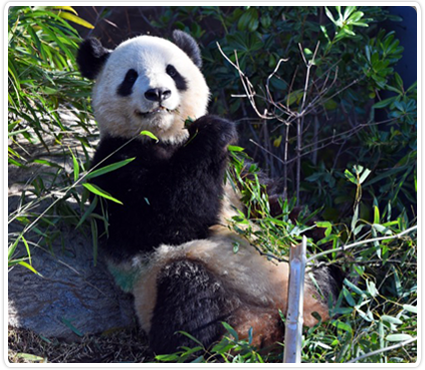


|
December 2025
 |
||||||
| Sun | Mon | Tue | Wed | Thu | Fri | Sat |
| 1 × |
2 | 3 | 4 | 5 | 6 | |
| 7 | 8 × |
9 | 10 | 11 | 12 | 13 |
| 14 | 15 × |
16 | 17 | 18 | 19 | 20 |
| 21 | 22 × |
23 | 24 | 25 | 26 | 27 |
| 28 | 29 × |
30 × |
31 × |
|||
×=Closed |
||||||
| Hours:9:30-17:00 | ||||||
Entrance and ticket office close 1 hour prior to closing time.
Ueno Zoo opens 9:30 to 17:00 (tickets sold until 16:00) and closes every Monday(closes Tuesday if Monday is a public holiday or Tokyo Citizen's Day [Oct 1]) and December 29 through January 1.
Exceptional opening days and hours: We open irregularly on some Mondays as well as on Tuesdays even if Monday is a public holiday. In summer, the zoo closes later than 17:00 (see more details below).
*Closing hours and temporary closure of animal exhibitions.
◎ From November 11, 2025
Please call +81-3-3828-5171 for information and update.
We record telephone calls to improve the quality of our customer service and to provide better guidance.
| General Admission | Annual Passport | |
| Adults (16-64) | 600 yen | 2400 yen |
| Seniors (65+) | 300 yen | 1200 yen |
| Students (13-15) | 200 yen | ── |
| Children (0-12) | Free | ── |
*Free for junior high school students living in Tokyo or attending schools in Tokyo.
*Groups of 20 or more paying individuals are entitled to a 20% discount providing the group enters together through one entry at one time.
*Free admission for the disabled, and one assistant per disabled person.
*The admission is free on March 20 (Ueno Zoo's Anniversary Day), May 4 (Greenery Day), and October 1 (Tokyo Citizens' Day).
We accept the following payment methods:
- Credit Cards (Visa, Mastercard, JCB, American Express, Diners Club, and Discover)
- e-money (Suica and all Suica-compatible IC transit cards)
- QR code payment (PayPay, Alipay, WeChatPay)
*Contactless payment and QR code payment is only available at staffed ticket windows.
*Please note that we are unable to recharge IC transit cards.

Gift shops, snack bars and restaurants. Baby strollers, coin-operated lockers, and wheelchairs (non-motorized) available.
We have no parking lots, but there are toll ones in the vicinity.
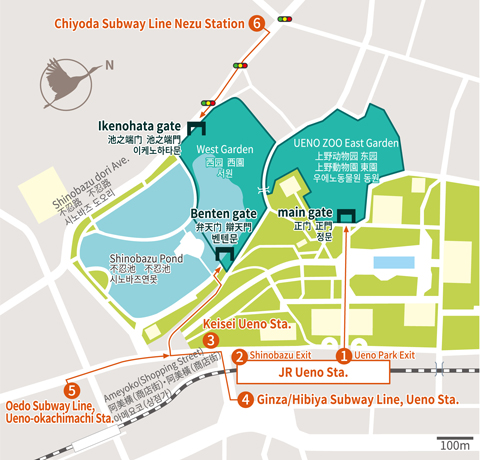
① 5 minutes’walk from JR Ueno Station Park Exit.
② 5 minutes’walk from JR Ueno Station Shinobazu Exit.
③ 4 minutes’walk from Keisei Ueno Station.
④ 8 minutes’ walk from Subway Ueno Station (Ginza/Hibiya Line).
⑤ 10 minutes’ walk from Ueno-okachimachi Station (Oedo Subway Line).
⑥ 5 minutes’ walk from Nezu Station (Chiyoda Subway Line).
*We have no parking lots, but there are toll ones in the vicinity.
Address: |
Ueno Zoo, |
Phone: |
03-3828-5171 We record telephone calls to improve |
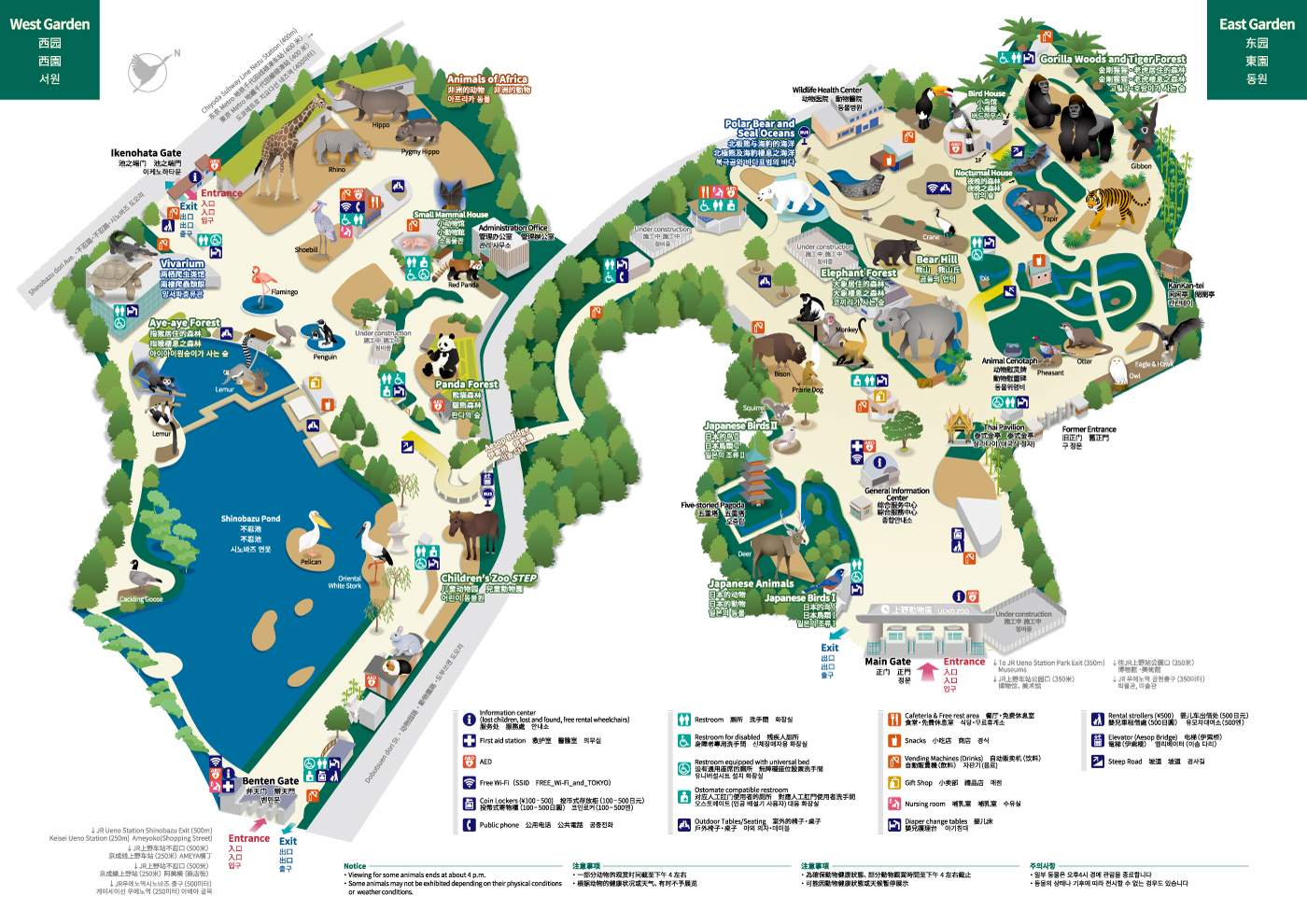
Click here for a printable PDF map.
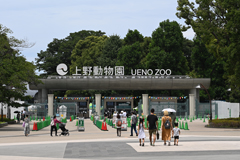 Ueno Zoological Gardens is the first modern zoo in Japan. Founded in 1882, it has grown over the years, expanded its area to 14.4 ha (35.6 acres) and been the flagship of the Japanese zoo world. Now it's home to over 3,000 animals from 300 different species and provides visitors with learning experience about the diversity of animals as well as fun and enjoyment.
Ueno Zoological Gardens is the first modern zoo in Japan. Founded in 1882, it has grown over the years, expanded its area to 14.4 ha (35.6 acres) and been the flagship of the Japanese zoo world. Now it's home to over 3,000 animals from 300 different species and provides visitors with learning experience about the diversity of animals as well as fun and enjoyment.
 In its long history, Ueno Zoo has received numerous animals from abroad. In 1972, the first giant pandas arrived from China at Ueno Zoo. We have been cooperating with Beijing Zoo (China) and San Diego Zoo (US) in the breeding of wild giant pandas. After Ling Ling's death in 2008, Ri Ri and Shin Shin arrived at the zoo in 2011. Shin Shin gave birth to Xiang Xiang in 2017, and to twins Lei Lei and Xiao Xiao in 2021. Xiang Xiang and the parents were returned to China in 2023 and 2024, respectively.
In its long history, Ueno Zoo has received numerous animals from abroad. In 1972, the first giant pandas arrived from China at Ueno Zoo. We have been cooperating with Beijing Zoo (China) and San Diego Zoo (US) in the breeding of wild giant pandas. After Ling Ling's death in 2008, Ri Ri and Shin Shin arrived at the zoo in 2011. Shin Shin gave birth to Xiang Xiang in 2017, and to twins Lei Lei and Xiao Xiao in 2021. Xiang Xiang and the parents were returned to China in 2023 and 2024, respectively.
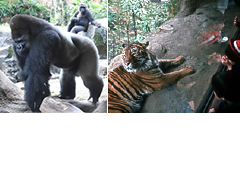 In the "Gorilla Woods" and the "Tiger Forest," you experience the thrill of facing nose-to-nose with those amazing wildlife. In an effort to breed endangered species, we have organized nationwide and worldwide zoo networks and share experience and knowledge of animal husbandry and management.
In the "Gorilla Woods" and the "Tiger Forest," you experience the thrill of facing nose-to-nose with those amazing wildlife. In an effort to breed endangered species, we have organized nationwide and worldwide zoo networks and share experience and knowledge of animal husbandry and management.
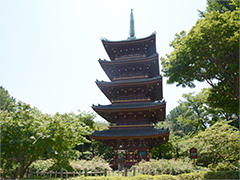 The Five-storied Pagoda and the tea ceremony house give the zoo a Japanese touch.
The Five-storied Pagoda and the tea ceremony house give the zoo a Japanese touch.
The pagoda was built in 1631, rebuilt after destruction by fire, and in 1958 the owner, Kan'ei-ji temple, gave the pagoda to Tokyo Metropolitan Government, who assigned its management to Ueno Zoo. The tea ceremony house was built to entertain Shoguns in 17th century, and it stills stands as a historic structure in the zoo ground.
*Virtual tour of Ueno Zoo ☞ Five-storied pagoda, Rock ptarmigan, Lidth’s Jay, Deer and Serow.
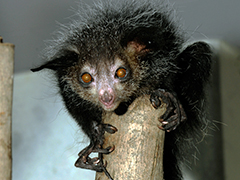 Aye-ayes are quite rare species, which came to Ueno Zoo as a part of international breeding cooperation. We have succeeded in breeding of aye-ayes as well as pygmy hippos, which are also endangered in the wild.
Aye-ayes are quite rare species, which came to Ueno Zoo as a part of international breeding cooperation. We have succeeded in breeding of aye-ayes as well as pygmy hippos, which are also endangered in the wild.
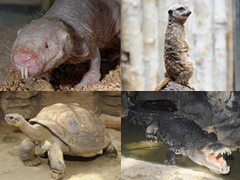 In the Small Mammal House, you'll find the wonder of nocturnal animals.
In the Small Mammal House, you'll find the wonder of nocturnal animals.
In 1999, the Vivarium (Reptile and Amphibian House) has been completed, where world's rare fishes, crocodiles, turtles, snakes and frogs can be seen in the green house.
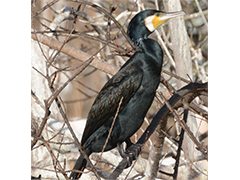 Shinobazu Pond in the West Area is a unique habitat for wild common cormorants, Phalacrocorax carbo, which once were seen everywhere in Japan, but now are endangered.
Shinobazu Pond in the West Area is a unique habitat for wild common cormorants, Phalacrocorax carbo, which once were seen everywhere in Japan, but now are endangered.
*Closing hours and temporary closure of animal exhibitions.
◎ From November 11, 2025
*As health management or weather condition, some animals are taken to their den earlier than the closing hour.
Asian elephants, pheasants, snow owls, raptors, Sumatran tigers, western lowland gorillas, Nocturnal House (Chinese pangolin, slow lorises, bats), South American tapirs, cranes, harbor seals, bears (polar bears, Hokkaido brown bears, Japanese black bears), otters, sacred ibises, birds of Japan, monkeys (Japanese macaques, white-mantled black colobuses, black-handed spider monkeys), prairie dogs, American bisons, etc.
Giant pandas, African animals (black rhinos, hippo, pygmy hippos, giraffes), aardvarks, ruffed lemurs, ring-tailed lemurs, aye-ayes, Small Mammal House (rodents, bats, armadillos, nocturnal animals), Vivarium (galapagos tortoise, saltwater crocodile, green iguana, geckoes, Japanese pond turtles, and other reptiles and amphibians), Children's Zoo (guinea pigs, rabbits, goats, and other domestic animals), etc.